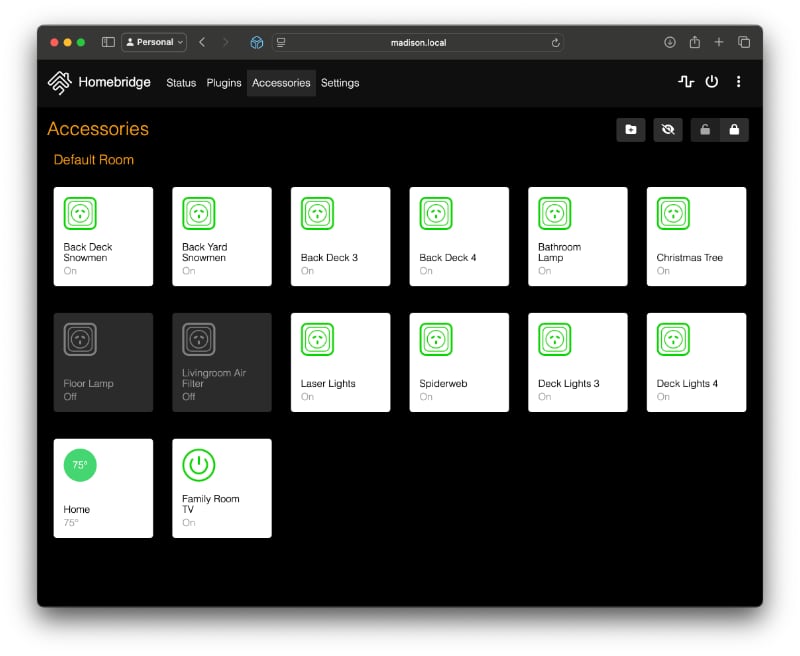
I’ve been tinkering with the smart home for the better part of a decade now. The love-her-and-hate-her Amazon Alexa has ruled the roost with a rusty iron fist the whole time, the only device capable of bringing the different pieces I bought together. Homebridge is a free tool that is changing that for me.
I like a lot about the Amazon Echo ecosystem. If, for the sake of argument, we assume Amazon will honor its privacy commitments, Alexa is the best smart home hub for one reason: sheer prevalence. Whether you pick up one of TP-Link’s modestly priced smart plugs or a bargain smart home device that goes on sale at Aldi (guilty as charged), almost everything supports being controlled by Alexa.
There are two ways one can approach the smart home. The superior option, if you really know what you need, is to pick a single ecosystem of products that covers all your needs and run with it. That keeps things simple. But for those like me that have dabbled with different things because of changing needs (or limited budgets), a mishmash of products is the alternative option.
Some were cheap. Some were simply the only tool for a job at the time I was in the market. A flawed hub to bring sense to that menagerie is a sanity-saver.
In addition to the voice control itself, Amazon has embraced its smart home role by making the Alexa iOS and Android app moderately better for when one wants to control things visually rather than by voice. Emphasis on moderately: no one would give the Alexa app an award for user experience design.
The downsides continue beyond the middling UI. One is being locked into Amazon device-by-device. Everything Amazon sells is subsidized with the point of selling more things from Amazon. Do I really want to depend on that? Do I want to trust a company that specializes in converting its knowledge of me into sales pitches to be the keeper of my lights and security system?
No, of course not.
The better path for a smart home has always been Apple’s. My fanboy-ism aside, their plan has always laid out a privacy centric approach. HomeKit requires careful implementation of encryption, prefers in-the-home processing to reduce dependency on cloud control and utilizes Apple’s end-to-end encryption. Apple has a sterling, if draconian, reputation for being a home control privacy stickler.
That doesn’t come cheap. The problem with HomeKit devices has always been the problem with whatever the American military dreams up these days: the specifications are over engineered to the point that the result is prohibitively expensive.
With a few exceptions — Philips Hue comes to mind — HomeKit devices cost double or triple Alexa-only counterparts. The cost reduces sales, which makes them harder to find. The reduced volume exacerbates the cost issues.
All that to say, outside Philip’s genuinely excellent and useful Hue bulbs, everything I used that could be smart home-enabled lacked HomeKit support.
My HVAC got replaced and it came with a smart thermostat without HomeKit. I wanted to wire up Christmas lights and used TP-Link’s excellent outdoor Kasa smart plugs — but didn’t opt to spend extra for the HomeKit version. So it goes.
Getting largely non-HomeKit accessories creates a vicious spiral even as I would prefer the privacy-centric Apple system. Having most of one’s smart home outside of Apple Home is a disincentive for getting HomeKit devices, at least unless they cost the same. I don’t want to have to remember, “Oh, only the backyard Christmas lights can be turned on by Apple Home, the front is via Alexa.” What good is it to pay double if I’m just going to use the device with Alexa anyway?
Matter was supposed to solve this, bringing together the Google, Apple, Samsung and Amazon ecosystems. Two snags temper my enthusiasm, for the time being. First, I am not swimming in cash, so replacing everything just to get it all to talk to each other is not a high priority for me. Second, Matter has rolled out in a bumpy fashion that hasn’t yet achieved its promise even if I were given everything needed as a gift.
Homebridge is a much needed bandage to this problem, making non-HomeKit devices act like they supported HomeKit. The project is open source and easy enough to install almost anyone with about 20 minutes and a slight bit of patience could get it up and running. The end result does what Matter can’t yet.
It can be installed on an old computer, a Raspberry Pi, or a variety of other devices (I’ve tried it on a low-powered QNAP NAS, an old Mac mini, and a tiny mini Intel-based PC, for example). You can even install it as a background process on your desktop computer, but emphasis on desktop: you want Homebridge to run continually, not just when your laptop is powered up.
Homebridge performs reasonably quickly even on the modest hardware I settled on. After the initial installation, it has a friendly web-based user interface you can log into to add a series of plugins and control devices. The plugins serve as the glue between Homebridge and whatever devices you have around your home. Most of those plugins install with no more effort than an app on the App Store.

My early smart home security system, consisting of door contact sensors and such, used the (now fading) Z-Wave standard linked to Samsung’s (now quasi-discontinued) SmartThings hub. Homebridge made it all 2024 HomeKit-ified without fuss. The likewise Z-Wave-based garage door controller I’ve used since my door’s remote control receiver broke now is as Siri-friendly as any Apple-certified option.
The only caveat with importing SmartThings into Homebridge is that it worked too well. My Hue lights that natively support both SmartThings and HomeKit came in and appeared as duplicates within Apple Home. A configuration option on the Homebridge SmartThings plugin makes it trivial to hide duplicates, thankfully.
The TP-Link plugin was similarly uneventful. All of my Kasa smart plugs came in and work as well as they do via Alexa or the native Kasa app. A small hack I’ve not yet endeavored, but comes with good reports online, even allows one to add the off-brand Atomi smart plugs I’ve been unable to resist at Aldi.
When enabling plugins, Homebridge can either have them run within the main Homebridge server or make them into “sub-bridges.” Both options work just fine. In theory, the latter option will improve stability if something goes wrong, but with the inconvenience that each sub-bridge must be added to Apple Home as if it were a separate device.
Adding those bridges is the last step. Once the plugins are in place, the “bridge” (and any sub-bridges) are imported into Apple Home as if they were normal, new HomeKit devices.
When you unbox, say, a Hue light system or a HomeKit-enabled thermostat, it will come with a QR code that can link it to Apple’s smart home controller. Homebridge generates the same for each bridge, and adding it to Apple Home adds all the devices linked within Homebridge to Apple Home.
A small warning will appear at first, noting that Homebridge isn’t certified for HomeKit, but let not the warning trouble you: it can be safely accepted. I first installed Homebridge about a year ago and have had zero issues with it.

My garage door controller did quit responding one inconvenient day when I’d forgotten my keys, but it wasn’t Homebridge’s fault. My tiny computer’s minuscule hard disk filled from something else and clogging things up. Lesson learned: if you are going to use Homebridge on a device also handling other projects, make sure those other things don’t get in the way.
Is it as ideal as a true HomeKit setup (or the idealized Matter setup of the future)? No. Much as I love them, the TP-Link switches, for example, are still cloud-based with all the security questions and issues if your connection goes down as they were prior to Homebridge. Ditto many of the other things I’ve linked.
It’s a stopgap. But a good stopgap.
A great many of us use these sorts of flawed, but useful devices every day. Bringing them into Apple Home has allowed me to start being less dependent on Alexa as my home controller. It also makes it more sensible for me to add other genuine HomeKit devices as the need arises, since the existing things are already there rather than hiding somewhere else.
A bridge, at its best, gets us from where we were to where we need to head. That’s what Homebridge does for my smart home (Homebridge.io, free/Open Source).

Timothy R. Butler is Editor-in-Chief of Open for Business. He also serves as a pastor at Little Hills Church and FaithTree Christian Fellowship.
You need to be logged in if you wish to comment on this article. Sign in or sign up here.
Start the Conversation